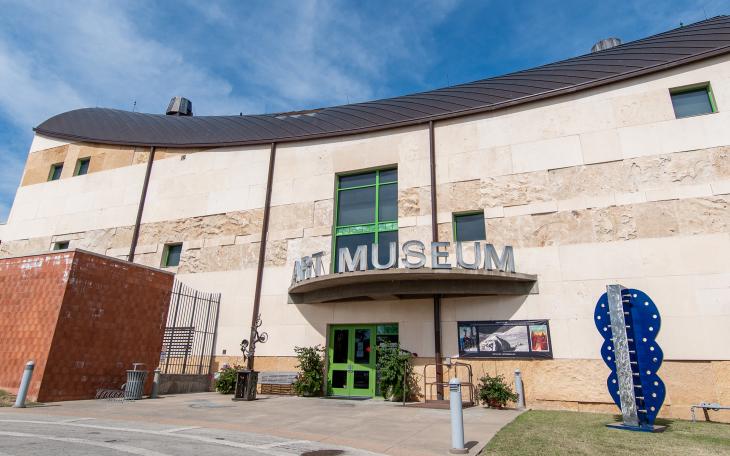The overwhelming amount of rainfall in certain areas of Texas has received in the past week or so has created a dire situation for some, as floods have destroyed communities across Texas. In a press conference on Monday, Governor Greg Abbott declared a state of emergency in 24 counties in the state. Shortly before the conference, he flew over the area south of Austin to assess the damage caused by heavy rainfall, flooding, tornados and straight line wind damage that forced evacuations, rooftop rescues and power outages over the past week.
“Moments ago I had the opportunity to fly over Blanco River and to observe firsthand what the devastation looks like,” Abbott said. “And, you cannot candy coat it, it is absolutely massive. Because of the level of devastation I have announced today that Hays County, Caldwell County, Bastrop County as well as some other counties around the state of Texas have been included in my disaster declaration. Whenever local elected officials or anybody warns people to get out of way, to abandon where ever they may be and to evacuate, the devastation that we have seen is a reminder to heed those warnings.”
In Hays County, emergency officials began sending out alerts to residents warning of the rapidly rising river at 6:30 p.m. Sunday, as the river rose 12 to 14 feet in 30 minutes, according to Kharley Smith, the emergency management coordinator of Hays County.
In every Texas county and city there is an Emergency Management Coordinator that is in charge of what could potentially be lifesaving decisions similar to the situations many flood victims have faced in the past week.
Specifically they are responsible for responding to public emergency incidents and providing necessary support to responders, training personnel, advising local government officials on emergency management issues, coordinating with outside agencies on emergency management matters, and overseeing the Emergency Operations Center and the local warning system.
In San Angelo, citizens look to Steve Mild. Mild has been the acting Emergency Management Coordinator for both the city and county since November of 2013. He worked in law enforcement for 43 years and was a captain in the Tom Green County Sheriff’s office before accepting the position he still holds as the city/county emergency management coordinator.
LIVE! spoke with Mild last week in his office at the Emergency Operations Center located close to Mathis Field. The topics of discussion ranged from job responsibly to Mild’s idea of a “perfectly prepared world”.
“One of the misconceptions that a lot of people have is that as the emergency management coordinator, it’s my responsibility when a disaster hits to take care of everything,” Mild said from behind his paper-stacked desk in his office at the emergency operations headquarters. “Nothing could be further from the truth, when the disaster hits, my job is done. At that point I basically become a gofer.”
Mild explained that he acts as a liaison between the city, county and state. He left his office for a second and came back in carrying a white six inch binder filled to the top with papers sectioned into alphabetical tabs, dropped it on his desk, and declared it the guide book of disasters issued by the city in which 22 annexes are written.
“It’s a book. A basic plan is every book has preface and it tells why the book was written who the key players are, all that kind of stuff, and then it has chapters. With our plan—the basic plan itself—is the preface of the book, the annexes are the chapters in the book, and each one of those annexes deals with a very specific situation, condition, or hazard and how the city of San Angelo responds to it. Then within some of those annexes you have tabs or Annex A which I am in the process of revising,” he said lifting some loose papers off his desk.
“Annex A has six tabs in it, those deal with very specific things. It has to do with all sorts of warning. Area warning, highway tie-in to the Texas Fusion Center, concept of operations, how the City of San Angelo receives warnings and then it goes into the national state warning systems all of that. One of the tabs is what is the City of San Angelo’s policy on sirens and when do we set the sirens off.”
Mild says when to activate the sirens is an issue that is addressed almost annually. Some citizens call to complain that the sirens went off in conditions they felt unnecessary, and others to complain about even the monthly test that runs on the first of each month at noon.
“Once again we are going to sit down and look at it in light of what has happened,” he said referring to the last time the sirens where sounded by the San Angelo Fire Department Battalion Chief due to high winds a few weeks ago.
“Regardless of what your standards are, there’s no question at all and there never has been a question as to whether the sirens should go off if there’s hail of a quarter inch or larger,” he said. “Where the problem comes in is the wind. A lot of people don’t understand that straight-line winds are a lot more devastating over a large area than a tornado. Other than if you get an F3 or larger tornado then you are going to have pretty wide spread damage but you get more wind damage events every year from straight line wind than you do tornado, and so it becomes important to warn your people if there’s gonna be winds coming to do damage.”
At what exact velocity of wind speed are sirens set off to warn of straight-line winds?
“We set them off when the wind speed exceeds 58 miles per hour, which is the minimum speed that the National Weather Service uses for a severe thunderstorm warning.”
Last week the state was calling Mild’s office asking for a damage report from the floods that Tom Green County sustained.
“When it becomes obvious we have had damage I will need to report to the state as soon as possible what our damage is here and approximately what the cost may be to recover and respond to that disaster,” he said. “ Because for a disaster declaration to be made, a certain monetary threshold has to be met, so by those reports by these weather events that are long moving, causing major damage. If each jurisdiction would individually report the damage they’ve got the state could aggregate that to reach the state threshold to be able to get declared a disaster, so we can start getting reimbursed for what we spend on the disaster response and getting the initial helping that we need.”
Mild says that he started up an e-mail to assist him with this.
“If you are out taking pictures of this damage that has happened in the storm, send me a copy of it with the location, and you can do that by sending it to [email protected]. I want everybody in the community to do that. What has happened up until now is that I have to go out or send teams out to do damage assessment and it maybe four, five or six hours until I can even start to get close to an accurate account of what the damage is. But if I’ve got 50,000 people out there that are taking pictures of this damage and they are shooting the pictures to me; within a matter of 30 or 45 minutes I could call the state and say, hey we’ve got a lot of damage here, I can send you picture proof of it. That’s going to expedite all of those processes that we need to go through to be able to make our reports if necessary for our mayor or county judge to be able to declare a local disaster and be able to pass it on up to the state disaster operations.”
Mild says that he and his recently hired part time secretary are the only staff in the emergency management office; he does not have a crew to send out to assess damage. Although another project he is working on is coordinating with the city to implement the same type system with city employees making the guesstimation he reports to the state as close to accurate as possible. He sent an e-mail out to each of the city departments that morning asking them to survey their damage and give a rough estimate of the monetary value of the damage sustained.
“In the training that you take, they tell you not to be conservative with your estimate because it’s easier to come along and say our loses aren’t what we thought it was gonna be, it’s not going to be a million dollars, now we have had a chance to look at it so we are only looking at $700,000,” he said, giving an example. “And the state would say fine. FEMA would say fine. If you sit there and say that you probably only had about $700,000 worth of damage and you didn’t really get into it and see it right off the bat and you discover something later, then you have to say [we were wrong] we are actually looking at more it’s harder to adjust that number up than down.”
Mild had been out surveying some damage around the airport and lake area as was evident by the dried mud on the sides of his city vehicle, a white Dodge Charger. At the time he said the primary damage looked to be contained to just the roads and trees.
“There’s been more tree damage around the lake than in or around town that I’ve seen,” he said. “All of the reports from the city so far to buildings are roof damage. It appears road damage was the main thing reported so far.”
Up until Monday, Texas has not declared a state of disaster since 2013 when floods attacked roadways causing more than $1.1 million in damages in central Texas.
At a San Angelo Tea Party at the end of April, Mild gave a presentation titled “Emergency Preparedness is an Individual Responsibility”.
“You are responsible for you,” he said. “You need to understand yourself as an individual and when I say that; are you the type of person when you see some blood you pass out or you go crazy and loose it or are you the type of person when something happens around you that is something out of the ordinary you are able to keep your calm and deal with it cool, calm and collected. Understanding that then will give you guidance on how you need to plan for the rest of everything that needs to be done. So if you are the type of person who just falls apart all of the time you need to be sure that when, like the situation is right now, where we could have a tornado at any time, you need to be sure and have people around you who are able to think calmly and coolly if a tornado should hit because you are not going to be able to do that so you need to have your what I term as crutches. I don’t mean that negatively because every single one of us has to have crutches or some support.”
And if a large disaster strikes the county, Mild gave an example of a system he described as ideal and would like to see implemented within communities everywhere.
“One of the big things I’m working in now that has really started to catch on is working through churches, and the way this started out is that our church broke down all of the membership into groups or cells,” he said. “Members in the cell are all within walking or bicycling distance of everybody else except for one person, and that one person that is not within that distance is far enough outside that if a major tornado comes through the likelihood of them getting hit would be much less. So what happens then is that you have this cell, a storm comes through, the cell leader does the call downs to each person on the list to check on them. You quickly find out what their status is, where they are, who needs help, what kind of help do they need and all of that. Then you can reach out to the person outside the cell if you have a system communicating with them to let them know. Then they can start the communication process with the people in that cell and the internal cell can communicate with their family members or with other people to let them know they are okay and then this person can start doing that for them.”
“If the church itself has some basic supplies and stuff that they can help their church members with like plastic to put on roofs and windows and all of that kinds of stuff,” he expanded. “It’s so that you are not relying on the city having to come in or other groups like that having to come in. The more that these types of groups can do that for their membership, the less that’s going to draw on the other volunteer organizations that are put there that are also having to struggle, spreading out their supplies to a whole bunch of people. So you are taking this responsibility and spreading it out but containing it if you can, within these groups so that by doing that you are stressing the first responders less. You are stressing the whole system less. You are able to fully account for people.”
When Mild is out in the community speaking he says he tries to stress the importance of having family plans for escapes from house fires, what to do in a tornado, and where to meet if you are separated. Mild says having these plans in place will help not only family members but also first responders.
“First of all to be able to reach out to other family members and let them know you are okay or to let them know what the status is of your family and family members. If you don’t have that, then people are going to be looking for you, you are going to be here, there, wherever and it’s just going to make things that much worse. Do you have a support system in the community outside of your family?” he asked.
“At least one person in the family needs to know basic first aid. You need to have more than just the basic kit that has more than Band-Aids in there. That’s the type of preparedness we need starting at the bottom and working your way up, so that by the time you get to my level and you start working on that book in there (referring to the annex) then you are talking about serving the whole community.”
While Mild’s roots are in law enforcement, he believes his lessons there have been a value asset for his job now.
“Even though I was in law enforcement a lot of the duties that I had lead me to get involved with firefighting. I’m a volunteer fire fighter, and have been a fire fighter for 20 years,” Mild said explaining his past experience prior to his current position. “Part of my duties with the county was to also to take care of the emergency management matters. So, I had a dual job with the county in doing my law enforcement duties, but then also taking care of the emergency management issues. I did all of the basic emergency management training and a lot of the advanced emergency management training. I became very involved in emergency management at the state level by serving on several different advisory groups, work groups, on committees. I have also been involved at the regional level on the emergency planning advisory council. I helped to design the regional communications interoperability plan, and have been very active there for about 15 years.”
One could say Miles job was inadvertently perfect for him given his background.
“Several years ago when the discussion came up about what makes a good emergency manager [a] person made a statement that the emergency management coordinator has got to be a person who has sufficient experience out on the streets, on the frontline, in all sorts of disaster responses,” he said. “But that is also a person who can put an effective team together and that is willing to educate in the community as a whole on what their responsibility is in disaster response. I thought it was a pretty accurate description of what we have to do.”
Subscribe to the LIVE! Daily
Required






Post a comment to this article here: